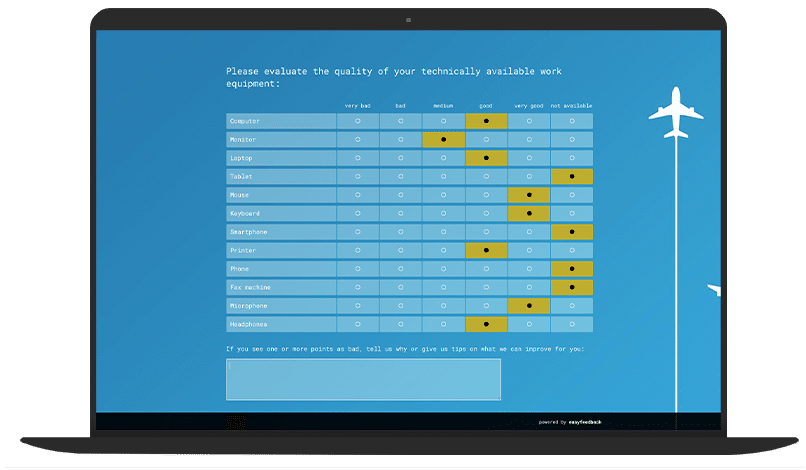Expectations on both sides
No wonder that more and more attention is paid to onboarding. According to Haufe, almost 15 percent of all new employees think about quitting their jobs on their first day of work. Overall, one third cancel their contract by the end of the trial period.
The question that HR professionals should ask themselves:
How can we arrange the entry into the new job in such a way that the spark is ignited and the new employee starts to get excited about our company?
The answer to this question:
Systematic onboarding programs that are integrated into Talent Management and, at best, digitally supported.
But the first time on board is not just a time for the newcomer to try things out. The team also checks how the new employee fits in. Both sides have high expectations for the start.
In addition, both the employee and the company make comparisons – the employee with earlier familiarization phases, the colleagues with other newcomers.
What makes good onboarding?
What does onboarding mean?
You guessed right! The term comes from the English and stands for “Taking on Board”, getting someone on board. The onboarding process is not just a short process of getting someone on board, but covers the period from the signing of the contract to the end of the trial period.
Usually the process is divided into three phases:
- Preparation
- Orientation
- Integration
Onboarding is much more than just getting to know each other or setting up the workplace. To guarantee a smooth onboarding process, companies are increasingly using software solutions and apps in the course of digitalization.
Poor onboarding can be expensive
Good onboarding primarily ensures that your “newcomer” feels welcome. However, it is not only about the feel-good factor of the employee.
What does it mean for the company when a new colleague leaves early?
- If the collaboration doesn’t work out, you will have to search for new talent again, which costs time and energy
- You know from your own experience: You are missing an urgently needed manpower during the time of the search
- It can be expensive for you: Filling a new position usually costs 30 percent of your annual salary.
Minimum requirement:
These basics should be available
Without anticipating too much, there are absolute basics. First priority: the workplace.

Make sure your new employee has a desk, that phone and computer are working and email address is set up. How often have you started a new job yourself and spent weeks running after these basic requirements?

Train your employee in software, processes, team structure and hierarchies. Assign a colleague to whom he or she can approach as a mentor at any time. Remember that everything is new for him.
Onboarding facts
The advantages of good onboarding are obvious:
- The new colleague arrives faster at his job. If he feels well taken care of, he approaches the new position with greater motivation. The more valued he or she feels, the more confident he or she will be in his or her job and integrate into the company more quickly.
- An article on HR.com shows that a good onboarding program pays off: it increases employee loyalty by up to 25 percent and improves employee performance by 11 percent. In addition, onboarding programs increase the chance of employees staying at least three years by 69 percent.
- Conversely, if there is no organized onboarding process, 15 percent said it supported their decision to leave. By the way: Onboarding does not work in an express procedure. It takes eight to twelve months until new employees are on par with their colleagues.
- A Haufe survey from 2017 showed that the vast majority of those surveyed (84 percent) see potential for improvement in their current induction.
9 measures for successful onboarding
In order to optimize the onboarding of new colleagues, we present the most important steps:
1. Create an induction plan for new employees
Rely on systematic onboarding. The best way to do this is to prepare everything before the job starts. In addition to the workplace, technology and internal communication, you should develop a training plan tailored to the new employee.
This includes the introduction in the team, the induction in the company with all relevant processes and the individually tailored further training.
Determine milestones together with the new employee, provide feedback through an employee survey and take enough time to discover possible gaps.

An onboarding manual ensures that you don’t start from scratch for every employee. There you answer the most important questions in wiki style – preferably off- and online.
Guides and checklists are particularly suitable. You’ll be way ahead of the game when you introduce your team in tutorial videos, present the premises and explain important processes.
The smoother the initial phase, the faster your employee will be in top form!
2. Think of all phases of onboarding
Employee onboarding can be divided into three phases: the preparation phase, the orientation phase and the integration phase.
The preparation phase
Duration: From the date of the job offer to the day of starting work.
Goal: In the preparation phase you prepare the new employee, your team and yourself for the first day at work.
This includes that you contact the new employee in between, even if he or she might not start working for a few weeks. If he has to move, you can give him tips on finding a place to live or recommend the best kindergarten for him.
If a summer party or Christmas celebration takes place during this time, invite him. Then he can get to know his future colleagues in a relaxed atmosphere.
Checklist for the preparation phase for the employer:
- Set up the workplace (desk, PC, telephone, e-mail address, login to the system and access data, keys, …)
- Inform colleagues and involved parties
- Clarify open questions
- Draw up an orientation plan for the first day and the next weeks (including job description, organization chart)
- Clarify dress code and working hours
- Appoint a colleague as a mentor
- Send information about the company
- As supervisor, set the feedback appointments for the first three months.
The orientation phase
Duration: This phase begins on the first working day and lasts for the first three months.
Goal: The new employee gets to know the company, his colleagues and his tasks.
This phase can be divided into the first working day and the first week.
- First working day
Introduce the newcomer and assign him to his mentor, show him his workplace and explain the most important organizational matters. Important: Explain the onboarding manual to him so that he can easily find the answers to his most important questions. Offer him to come to lunch with you! That way he gets to know new colleagues directly. - First working week
During the first week, the new employee is guided through the building to get to know employees outside his or her department. He also familiarizes himself with the most important tools and areas of responsibility before he really gets started.
As a supervisor, it is best to meet with him or her once a week in the first few weeks to get direct feedback. The feedback meeting at the end of the first week is especially important.
In this meeting, you will clarify any open questions, what you like or dislike, and whether there are still fundamental issues to be clarified.

The integration phase
So, the first hurdles have been overcome. Slowly the employee gets used to the new job.
Duration: The integration phase can last between six and twelve months.
Goal: The new employee is fully integrated and handles tasks and projects independently.
To make this process even better, use introductory events, workshops, information days or team-building measures.
Offer your talent sufficient further training. Involve him/her in projects and, depending on the position, introduce him/her to the strategy and company goals. Feedback interviews are the key to successful onboarding.
3. Integrate your new employee on all three levels: professional, social and cultural
By the way, onboarding does not only take place on the technical level. The “newcomer” has to integrate professionally, with his know-how, socially, with his colleagues, and culturally, in terms of goals, principles and philosophy.
Questions for professional onboarding
• Is the newcomer being used according to his abilities?
• Is he over- or underchallenged?
• Does he know what he has to do and who he can ask?
Questions for social onboarding
• Is the newcomer integrated into the team?
• Is he appreciated as a full team member by superiors and colleagues?
Questions for cultural onboarding
• Does he identify himself with the company?
• Does he know why he does what he does?
• Does he go for the company?
4. Anchor the onboarding process in the company
It’s hard to believe: Although the induction phase contributes to a high percentage of employees staying with a company, only 14 percent of HR departments allocate an extra budget for onboarding.
Structured induction phases are essential to ensure that everyone involved knows how to make the new employee’s start easier.
At the same time, existing employees are relieved if sufficient material and processes are available for familiarization.
5. Arrange regular feedback and employee meetings
Even if in many companies not yet fully arrived: Regular feedback through employee surveys is important for the corporate culture! Especially in the initial phase, when the new employee does not yet know the company well.
Especially in the beginning it is important for him to know whether his performance is going in the right direction.
As a matter of course:
- Prepare for the interview and follow the feedback rules!
- Track down possible sand in the gears! Conflicts that are not addressed block the whole team, hinder social integration and reduce the overall result.
6. Standardise and automate the onboarding process
In Aberdeen’s “Onboarding 2011” study, the market researchers found that employee retention with standardized processes was 19 percentage points higher on average. Achievement of objectives and employee performance were also better.
When companies standardize every phase of the onboarding process, for example with checklists and guidelines, and define responsibilities and deadlines in advance, they save time and resources. Adapt standard onboarding programs individually to each new employee.
7. Use software and apps for your onboarding process
While many HR departments today use software for many HR processes, most onboarding processes are not yet digitally supported. There are now numerous specialized solutions for onboarding with helpful functions:
- They help the HR department’s backend to manage the processes for induction.
- In the front end, they guide new employees through the onboarding process on a branded user interface.
- Ideally, they contain all the relevant information needed to get started in the company.
- In the form of a wiki, new employees are quickly given an overview of company standards and rules, such as dress code, important process flows, time recording, vacation planning and expense accounting, as well as nearby parking facilities.
- Use e-learning modules to provide your employee with the necessary company or product knowledge.
Be careful not to flood your new employees with information.
You can prioritize them and prepare them bit by bit. An onboarding app designed specifically for the company shows him that you’re at the forefront of digitalization and innovation.
Compared to the intranet, it brings more mobility and flexibility, makes it easier to standardize the onboarding process and offers an even better user experience and playful learning. Thus you collect some plus points with the newcomer.
8. Use a professional survey tool for your onboarding process
In addition to software solutions and apps for the onboarding process, you can use a survey tool.

You can integrate this into your applications and, for example, create an onboarding quiz that asks for relevant company or product information. This way you can get your new employees on board quickly and easily!

9. You should avoid these mistakes at all costs
Avoid everything that does not reflect well on the company, looks unprofessional and does not appreciate your new employee. Ask yourself how you would have liked to be treated at the start.
Typical mistakes that can be easily avoided:
- Your receptionist doesn’t even know that a new employee starts today.
- Neither the HR department nor the supervisor welcomes the new employee.
- The workstation is not yet fully set up.
- Colleagues do not care about the new employee.
- It takes days until the employee can really get started.
It is enough that you make only one of the above-mentioned mistakes … and you will fail the new employee. Many of them then close down and are already looking for a new job in their heads.
Conclusion: If your employee is happy, you are happy
By now it should be clear how important the first day on board is for your new employee, your colleagues and the whole company. Because if your “newcomer” feels welcome, he is directly much more motivated.
This leads to a faster and better performance, which is a gain for the team and the whole company.
Of course, it is not only about the first day. If the first week has gone well, there is nothing standing in the way of full integration in the coming months.
If you get it right at the end of the onboarding process, chances are that you’ll have gained another employee who is committed to your company, stays with you longer and recommends your company to others.
Happy Onboarding!




